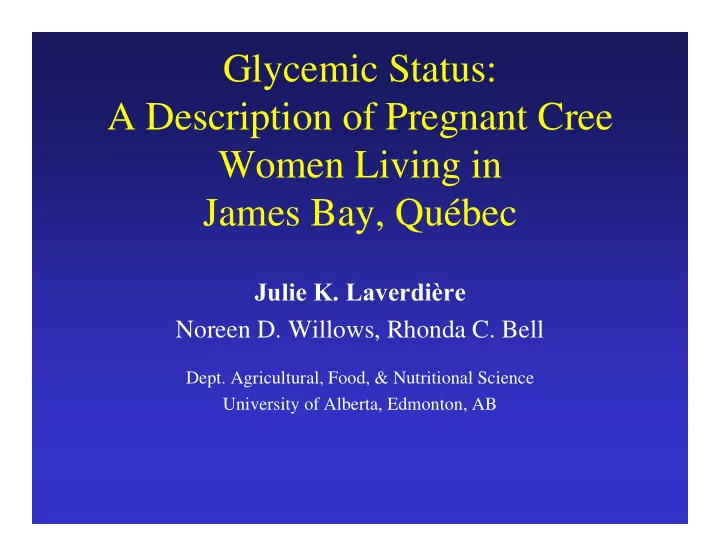

Glycemic Status: A A Description of Pregnant Cree i i f C Women Living in Women Living in James Bay, Québec Julie K. Laverdière Noreen D. Willows, Rhonda C. Bell Dept. Agricultural, Food, & Nutritional Science Dept. Agricultural, Food, & Nutritional Science University of Alberta, Edmonton, AB
Gestational Diabetes Mellitus Gestational Diabetes Mellitus “ Carbohydrate intolerance resulting in Carbohydrate intolerance resulting in hyperglycemia of variable severity with onset or first recognition during pregnancy ” o st ecog t o du g p eg a cy Meltzer. Diabetes 1991; 40 (suppl):197 Mother Mother Infant Infant – PIH, preeclampsia – Macrosomia – Type 2 diabetes – Hypoglycemia at birth – Type 2 diabetes
Background Information The sociocultural and biological determinants of overweight in Cree children Purpose: – To examine the growth of Cree children from 0 T i th th f C hild f 0 to 5 yrs of age. – To identify factors that may affect child growth To identify factors that may affect child growth (eg.anemia, type of feeding, maternal glucose tolerance)
Obj Objective ti To describe the physical characteristics of women with normoglycemia, IGT, and GDM g y during pregnancy.
M th d Methods • Medical chart review (1709 women) – January 1994 to December 2000 – January 1994 to December 2000 – Obstetric forms, laboratory reports, medical notes notes • 9 communities in James Bay Region • 9 communities in James Bay Region
Data Collected Early During Infant Pregnancy Pregnancy pregnancy pregnancy Characteristics Characteristics Weight g 50 g OCGT g Birth weight g Height 75 or 100 gm OCGT Age Fasting glucose
Diagnostic Criteria g All women are given f fasting plasma sample i l l All women have 50g OGCT All h 50 OGCT Normal glycemia: GDM: Further testing: <7.8mmol/l ≥ 10.3mmol/l 7.8-10.2mmol/l OGTT
GDM Diagnostic Criteria: GDM Diagnostic Criteria: OGTT CPG b – 75 gm NDDG a – 100 gm Time 5 8 5.8 fasting (mmol/l) fasting (mmol/l) 5 3 5.3 10.6 1h (mmol/l) ( ) 10.6 9.2 2h (mmol/l) 8.9 8.1 3h (mmol/l) a National Diabetes Data Group. Diabetes 1979; 28: 1039. National Diabetes Data Group. Diabetes 1979; 28: 1039. b Clinical Practice Guidelines. CMAJ 1998; 159: S1.
Prevalence Prevalence Glycemic Glycemic Number Number % of Sample % of Sample Status 1296 1296 75 8 75.8 N Normal l Impaired Glucose 142 142 8 3 8.3 Tolerance (IGT) Gestational 271 15.8 Diabetes Mellitus (GDM) 1709 100 Total
Prevalence Prevalence Glycemic Number % of Sample Status • Normal Normal 1296 1296 75 8 75.8 • Impaired Glucose Tolerance (IGT) Tolerance (IGT) 142 142 8 3 8.3 • Gestational Diabetes Mellitus (GDM) ( ) 271 15.8 Total 1709 100
Body Weight Early in Pregnancy 100 86.9 86.1 * * 79.4 80 80 60 WEIGHT (kg) (kg) 40 20 20 0 NORMAL NORMAL IGT IGT GDM GDM *Different from NORMAL glycemic group, p<0.001
Body Mass Index Entering Body Mass Index Entering Pregnancy 40 33.8 32.6 * * 35 30 30 25 BMI (kg/m 2 ) 2 ) 20 20 (k / 15 10 5 0 NORMAL NORMAL IGT IGT GDM GDM *Different from NORMAL glycemic group, p<0.001
Maternal Age 30 26.8 * 25.5 * 23.3 25 20 Age (yrs) 15 15 10 5 5 0 NORMAL IGT GDM *Different from NORMAL glycemic group, P<0.001
Fasting Plasma Glucose Fasting Plasma Glucose Early in Pregnancy 6 Normal: < 5.3mmol/l 4.8 4.6 5 4.5 4.5 * 4 Fasting Plasma 3 3 Glucose (mmol/l) 2 1 1 0 NORMAL IGT GDM * GDM different from IGT & Normal glycemic group, p<0.001
Infant Birth Weight Infant Birth Weight Maternal Infant Birth % of Group with Glygemic Status Weight (g) Birth Weight >4000g Normal 3766 32.1 Impaired Glucose Tolerance 3900 39.4 Gestational Diabetes Mellitus 3970 48.5
Summary • A quarter of women has abnormal glucose tolerance • Women with IGT and GDM are heavier & older than those with normal glucose tolerance Women with IGT and GDM are similar • – Body weight, BMI, age Body weight, BMI, age
Conclusion • High prevalence of abnormal glucose tolerance • High body weight & increasing age are High body weight & increasing age are predisposing characteristics • Importance of universal screening
Acknowledgement Acknowledgement Community Members I. Kovitch, MD Clinic Staff Clinic Staff D. Dannebaum, MD Cree Board of Health & Social Services of AHFMR, NSTP, C/BAR , NS , C/ James Bay
Recommend
More recommend